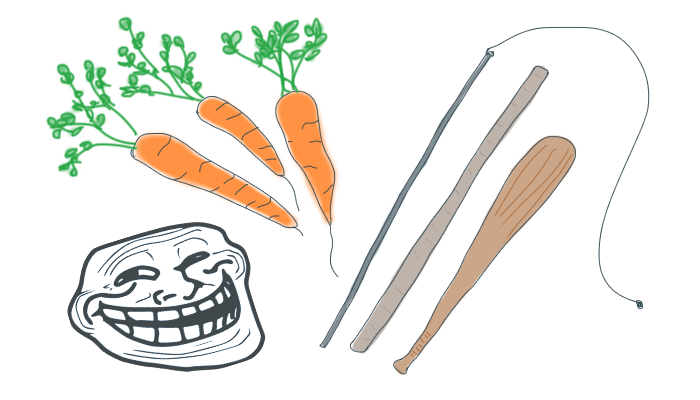
Carrots and sticks are so last millennium
How to encourage motivation to increase productivity
Motivation isn’t easy. Most companies try to motivate people with old-school theories of extrinsic motivation (external influences), the carrot and stick method. But carrots and sticks don’t work. So out with the external and in with the internal, self-motivation needs intrinsic factors (internal influences) to work.
This isn’t the carrot you are looking for. First, when we talk about motivation we mean the reasons behind people’s actions, desires and needs. If you are still working on that app that would make you the omnipotent world ruler with complete dominion over everyone around you; let me pause now to let you know that you can’t actually make people do, want or need things. But you can motivate them.
We used to think the best influences were extrinsic. You could positively reward behaviors you wanted repeated, the carrot – “There’s a bonus coming if you screw in 100 more cogs”! And you could negatively reinforce behaviors you wanted to curb, the stick – “Every cog you miss comes out of your paycheck”! This is the scheme most companies today work under, they dangle the carrot of higher salaries, promotions and bonuses in front of employees, hoping to increase performance for higher profits.
Using carrots and sticks with an engineer is like playing Pong, you should be having fun, but since it’s not 1975 you’re bored, and you might even put your phone back in your pocket. Extrinsic rewards work for simple, mechanical tasks, but these aren’t the jobs we want our teams working on. After all, that’s what we have interns for. We need our teams to solve problems, be innovative, and creative; for these tasks carrots fail. An analysis out of the London School of Economics found that "financial incentives may indeed reduce intrinsic motivation". Today’s teams will be reaching for their phones if intrinsic factors are tapped.
Daniel Pink, author of Drive – The Surprising Truth About What Motivates Us (2010) suggests that intrinsic self-motivation is what leads to better performance. He says after basic needs are met, focus on autonomy, mastery and purpose.
“I don’t have to care about money anymore!” #firstworldproblem #greatnewjob Money is still important, we need to be paid enough to meet our needs and feel like we’re being paid fairly. Once money isn’t an issue anymore, take it off the table and focus on autonomy, mastery and purpose.
Autonomy: We’ve been trying to do it our way since we were teens, why stop now? Pink says autonomy results in engagement. Since our tasks are complex and projects are defined more and more only in terms of the end-result we need to be engaged. Engagement means we’ll want to reason through the problems, be creative and find those innovative solutions. Autonomy allows us that freedom of thought.
Pink says that true autonomy has four parts: time, technique, team and tasks. Allowing people to choose when they work, how they work, with whom they work and even what they work on, we achieve true autonomy.
Google allows their employees to spend 20% of their time working completely autonomously on any task they want; giving them over half of their new products, like Gmail, Orkut and Google News. With ROWE, Results Only Work Environments, people have complete autonomy which has increased productivity, engagement, work satisfaction, and lowered turnover.
Mastery: There is no try, there is only do. Most people, and Jedi knights, will go a long way to get better at something. It’s human nature to feel a sense of accomplishment and satisfaction when you overcome and obstacle or meet a challenge. Pink suggests that allowing someone to tackle a challenging task, forcing them to learn or grow outside their comfort zones results in higher performance. The key becomes choosing the right tasks. Pink describes “Goldilocks Tasks” as tasks that should neither be too easy or they become boring and rote; nor should they be too hard or the challenge is insurmountable and people give up. You should find that sweet spot to foster learning, growth and improvement.
Mastery can take many forms. Employees can be challenged with leading, given new technologies to learn, or allowed to choose new tools (both autonomy and learning).
Purpose: Better things happen when it matters. There was once such a thing as Microsoft Encarta, people were tasked to create and maintain a digital Encyclopedia. Then along came Wales and Sanger, who said that the dissemination of information digitally on a global scale was an important task. They asked the world to contribute their time, knowledge and skills, for free, to support their lofty purpose -now we have Wikipedia. Elizabeth Kanter of Harvard Business School explains, “People can be inspired to meet stretch goals and tackle impossible challenges if they care about the outcome.” Pink argues that people intrinsically want to do things that matter, if they aren’t invested in the outcome they become disengaged and demotivated.
Giving a team purpose can be as easy as communicating the mission and goals of the company, helping a team to appreciate how their work fits into what the organization is about. Teams find purpose if they can connect to an outcome by knowing how it relates to real people, giving their work a human factor. Purpose can also happen by knowing that even the most menial of tasks fits into the bigger picture and can have enormous impact.
Teams today are asked to be innovative and create the future, we should support that by using autonomy, mastery and purpose to inspire a productive, effective and happier workforce.